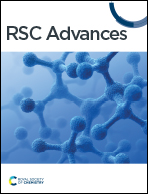Identification of the effect of N-glycan modification and its sialylation on proteolytic stability and glucose-stabilizing activity of glucagon-like peptide 1 by site-directed enzymatic glycosylation†
Abstract
In this study, an approach to prepare long-acting glucagon-like peptide 1 (GLP-1) by site-directed enzymatic glycosylation with homogeneous biantennary complex-type N-glycan has been developed. All the N-glycan-modified GLP-1 analogues preserved an unchanged secondary structure. The glycosylated GLP-1 analogues with sialyl complex-type N-glycan modified at Asn26 and Asn34 exhibited a 36.7- and 24.0-fold in vitro half-life respectively when incubated with dipeptidyl peptidase-IV (DPP-IV), and 25.0- and 13.9-fold respectively when incubated with mouse serum. Compared to native GLP-1, both glycosylated GLP-1 analogues modified at Asn34 by asialyl and sialyl N-glycan demonstrated lower maximum blood glucose levels, as well as more rapid and more persistent glucose-stabilizing capability in type 2 diabetic db/db mice. Our results indicated that the selection of an appropriate position (to avoid hindering the peptide-receptor binding) is crucial for N-glycan modification and its sialylation to improve the therapeutic properties of the modified peptides. The information learned would facilitate future design of therapeutic glycopeptides/glycoproteins with N-glycan to achieve enhanced pharmacological properties.



 Please wait while we load your content...
Please wait while we load your content...